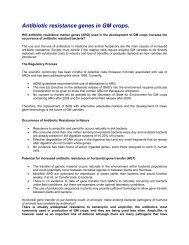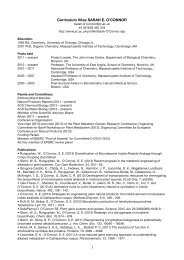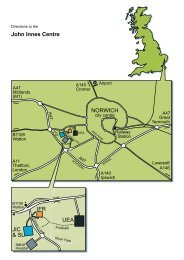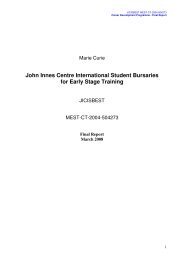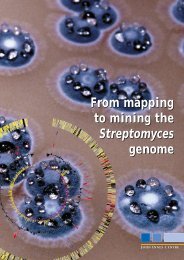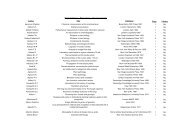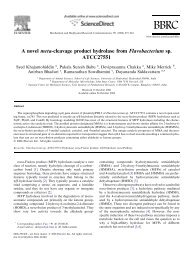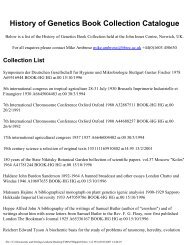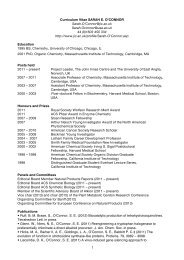Detailed Contents of "Practical Streptomyces Genetics" - John Innes ...
Detailed Contents of "Practical Streptomyces Genetics" - John Innes ...
Detailed Contents of "Practical Streptomyces Genetics" - John Innes ...
Create successful ePaper yourself
Turn your PDF publications into a flip-book with our unique Google optimized e-Paper software.
Chapter 11 Plasmids and their use for gene cloning<br />
General properties <strong>of</strong> <strong>Streptomyces</strong> plasmids and<br />
their use for gene cloning ............... 253<br />
Wild-type plasmids that have been used extensively<br />
to construct cloning vectors.......... 256<br />
pIJ101................................. 256<br />
pJV1 .................................. 258<br />
pSG5.................................. 259<br />
SCP2*................................. 260<br />
Higher copy number derivatives <strong>of</strong> SCP2* . 263<br />
SCP2* vectors as delivery systems for gene<br />
disruptions ..................... 264<br />
SLP1 and pSAM2........................ 265<br />
Other integrating vectors .................. 265<br />
List <strong>of</strong> special purpose vectors .................. 267<br />
Bifunctional E. coli-<strong>Streptomyces</strong> plasmids .... 267<br />
oriT (RK2) vectors for conjugation between E. coli<br />
and <strong>Streptomyces</strong> ................. 267<br />
cosmid vectors......................... 267<br />
Expression vectors ....................... 268<br />
Vectors with promoterless reporter genes ..... 268<br />
Positive selection vectors .................. 268<br />
Integrating vectors ....................... 268<br />
Unstable and temperature-sensitive plasmids useful<br />
for gene replacement and<br />
transposon delivery................ 268<br />
Vectors without the tsr gene................ 268<br />
Vectors with resistance markers other than the<br />
common ones .................... 268<br />
Vectors with blue/white selection (lacZ )<br />
in E. coli ........................ 269<br />
Chapter 12 <strong>Streptomyces</strong> phages<br />
The relevance <strong>of</strong> phages to <strong>Streptomyces</strong> genetics . . . 271<br />
Occurrence, isolation and storage <strong>of</strong> <strong>Streptomyces</strong><br />
phages .......................... 272<br />
Lytic and temperate phages ................ 272<br />
Phages from soil ......................... 272<br />
Phages from lysogens ..................... 272<br />
Phages as industrial contaminants ........... 273<br />
<strong>Streptomyces</strong> phage genetics ................... 273<br />
In vivo physiological and genetic studies...... 273<br />
Deletion mutants and DNA packaging limitation 273<br />
Phage DNA ............................ 273<br />
Uses <strong>of</strong> wild-type phages in the study <strong>of</strong> their hosts . 274<br />
Transduction............................ 274<br />
Localised mutagenesis using generalised<br />
transduction ..................... 274<br />
Restriction-modification systems ............ 275<br />
Storage <strong>of</strong> <strong>Streptomyces</strong> phages ................. 276<br />
Plaque assay <strong>of</strong> <strong>Streptomyces</strong> phages............. 277<br />
Single-plaque isolation <strong>of</strong> <strong>Streptomyces</strong> phages..... 278<br />
Preparation <strong>of</strong> high-titre <strong>Streptomyces</strong> phage stocks . 278<br />
Isolation <strong>of</strong> new <strong>Streptomyces</strong> phages ............ 279<br />
Isolation procedure I (direct method) ......... 280<br />
Isolation procedure II (specific enrichment).... 281<br />
Selection <strong>of</strong> potential transducing phages by<br />
pyrophosphate resistance .................. 281<br />
Generalised transduction <strong>of</strong> S. venezuelae using SV1<br />
phage .......................... 282<br />
Large-scale preparation <strong>of</strong> <strong>Streptomyces</strong> phage DNA 282<br />
Small-scale preparation <strong>of</strong> <strong>Streptomyces</strong> phage DNA 285<br />
Chapter 13 Cloning with phage vectors<br />
General features <strong>of</strong> C31 and its vector derivatives . 290<br />
Shotgun cloning with C31 vectors.......... 290<br />
Choice <strong>of</strong> C31 vectors for mutational cloning . 291<br />
Choice <strong>of</strong> C31 vectors for screening by<br />
complementation <strong>of</strong> mutants ........ 291<br />
or acquisition <strong>of</strong> new capabilities ............ 292<br />
Ligation conditions....................... 294<br />
Maximising and estimating insert frequency . . . 294<br />
Construction and stability <strong>of</strong> lysogens ........ 294<br />
Homogenotisation ....................... 295<br />
Application <strong>of</strong> C31 to gene fusions ......... 296<br />
General features <strong>of</strong> the C31::xylE vectors ........ 296<br />
KC862: a xylE-containing C31 derivative<br />
that gives yellow plaques<br />
only when carrying inserts with active promoters 296<br />
A single copy number promoter-probe vector,<br />
KC859 ......................... 298<br />
Vectors for in situ fusions <strong>of</strong> xylE to chromo<br />
somally located transcription units . . . 298<br />
Other phage-based cloning systems .............. 299<br />
Prophage transformation with phage SAt-1 <strong>of</strong><br />
S. azureus ....................... 299<br />
Phage-mediated transduction <strong>of</strong> plasmids ..... 299<br />
Vectors based on other <strong>Streptomyces</strong> phages . . . 300<br />
Use <strong>of</strong> integration functions <strong>of</strong> <strong>Streptomyces</strong><br />
phages.......................... 300<br />
Transfection ................................ 301<br />
Transfer <strong>of</strong> <strong>Streptomyces</strong> phage DNA onto<br />
nitrocellulose filters for “plaque hybridisation” . 303<br />
Preparation <strong>of</strong> C31 lysogens .................. 303<br />
Procedure A ............................ 304<br />
Procedure B ............................ 305<br />
“Low-tech” method for detecting C31 derivatives<br />
containing resistance genes .......... 306<br />
Use <strong>of</strong> glkA counterselection to select deletions from,<br />
or loss <strong>of</strong>, C31 prophages .......... 307



